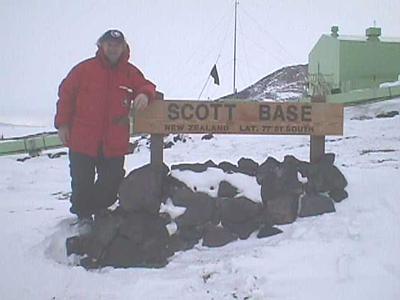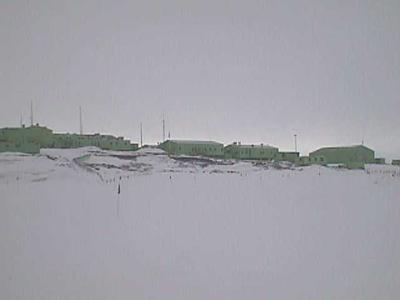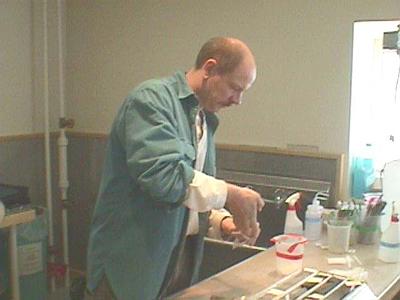7 November, 1999
The weather here is still overcast with blowing snow. The visibility varies
from a mile or so to much less. Yesterday the peak wind was about 70 miles
per hour. There has not been a fixed wing aircraft in or out of McMurdo for
about a week. There are a lot of people waiting in Christchurch to get a
flight to the ice. Helo flights have been very limited as well. A helo went
out to Cape Roberts to bring core samples back and to take some people out
there. I am scheduled to go to Cape Roberts tonight at 7:00PM NZT, but I
think the chances are good that the flight will be cancelled. If I don't
post a journal tomorrow, you'll know that I made it on the helo. I should
have a lot to tell you about when I get back. Wish me luck and hope for fair
skies.
Several days ago I had a wonderful opportunity to visit the center
for Antarctic research for New Zealand, Scott Base. Scott Base is located on
Ross Island about 2 miles by road from McMurdo Station. The station was
constructed in 1957 and rebuilt in the 1980s. Its site was selected by the
famous Kiwi Edmund Hillary, one to the two men to make the first ascent of
Mount Everest. It was built initially for the International Geophysical Year
and has served Antarctic science since. Scott Base was also the Ross Island
base of the British Commonwealth Transantarctic Expedition, whose goal was
traversing the continent from the Weddell Sea to the Ross Sea via the South
Pole in a manner attempted by Ernest Shackleton. The role of Scott Base is
the same as McMurdo Station, to support scientific research in Antarctica.
But that is where the similarity ends.
My visit to Scott Base was at the invitation of John Simes, the
person I work with in the palynology lab at Crary. The Kiwi station is much
smaller than McMurdo. Scott Base has a population of about 100 scientists
and support personnel compared to as many as 1200 at McMurdo. There is
regular travel between Mactown and Scott and there is even a shuttle
service. Many of the people working on the Cape Roberts Project are lodged
at Scott Base. Several people, including John, commute regularly between the
two bases. Despite the close proximity of Scott Base to McMurdo Station,
there have been several times when the weather has been so bad that travel
between the two bases was prohibited. People were stranded where they were.
Because Scott Base is so small, it has a much different environment and feel
than the relatively hectic pace in Mactown. It has much more of an intimate
or lodge atmosphere. The quarters are more confined with some sleeping rooms
accommodating as many as 6 people. Two or three is typical in McMurdo in a
room of similar size. Most of the buildings are connected by passageways.
The dining room is, of course, smaller. The meal I had there was excellent
though there was only a single choice of meal. The atmosphere is very cozy
with a delightful British feel to the conversations and traditions,
including afternoon tea. Following dinner, each person cleans his or her own
dishes and stacks them in the racks. People staying at Scott Base share
duties of maintaining the camp.
Another thing that sets Scott Base apart is that all of the
buildings are the same green color. This gives the base a very tidy and
organized appearance. Scott base has a helo pad, storage buildings, store,
bar, and a hydroponic garden where lettuce and herbs are grown. It was very
warm and humid in the hydroponics building. It was quite a change from the
dry, cold, windy weather outside. After dinner, John and I took a walk out
on the sea ice along a safe, flagged route. In the distance, we could see
the edge of the permanent ice of the Ross Ice Shelf and the landing field
that will be used after the sea ice runway becomes unsafe, Williams Field.
Seals are often seen near the cracks created by the pressure ridges in front
of Scott Base. Following my visit to Scott Base, I took a shuttle back to
Mactown. I hope I get to visit again.
Remember, I will be starting the evaporation experiment on Monday (If I get
back from Cape Roberts). If you need a copy of the experiment, please
request one and I will send you a MS Word document with the experiment.
Today's featured CRP Team Members are Tom Janecek and Matt Curren both from
the Florida State Antarctic Marine Geology Research Facility in Tallahassee,
Florida. Tom is the project Curator and Matt is the Assistant Curator. A
curator's job is to care for the core samples as they are delivered from the
drill site. They set the core out for the scientists to exam each day. After
the various disciplines choose which part of the core they want to sample,
Tom and Matt cut these pieces out of the core and package them for the
scientists. They are also responsible for archiving the core for future
study.

Me on my visit to Scott Base, Antarctica.

The green buildings of Scott Base seen from the sea ice.

Lush green plants in the hydroponics garden.

Tom Janecek, the "Keeper of the Core"!

Matt Curren cutting samples from the core.
Contact the TEA in the field at
.
If you cannot connect through your browser, copy the
TEA's e-mail address in the "To:" line of
your favorite e-mail package.
|
